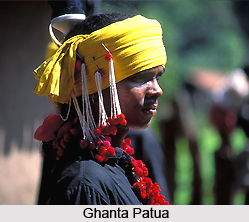 The Ghanta Patua is the community of Jagatsinghpur district situated in Odisha (formerly known as Orissa) state of India. The community performs an acrobatic dance popularly known as "Ghanta Patua dance" during the Hindu month of Chaitra that falls in the month of March-April.
The Ghanta Patua is the community of Jagatsinghpur district situated in Odisha (formerly known as Orissa) state of India. The community performs an acrobatic dance popularly known as "Ghanta Patua dance" during the Hindu month of Chaitra that falls in the month of March-April.
During the whole month of Chaitra, the village streets in Odisha reverberate with the jingle of Ghanta also known as brass gong. These are played by Ghanta Patuas in accompaniment to their peculiar dance on the stilts which is very similar to the Karaga dance of Mysore. The dance is dedicated to the Mother Goddess who is known by various names like Sarala, Hingula, Charchika, Bhagavati, and Chandi.
Dance Performance by Ghanta Patua
Ghanta Patuas are the non-Brahmin Sevaks or servants who perform the services meant for the deities. During the auspicious Chaitra, with the blessings of the respective deities attached to the shrines, they set out in groups of two to four dancers. They perform their dance balancing on a rope tied between two poles.
The main dancer dresses in a female attire with a black colour bandana tied on the head like a round cap while the flowing two ends held by him in both the hands separately. He also bears the Ghata or sacred pitcher on his head. The pitcher is tastefully decorated with flowers, sandal paste, vermilion and coloured threads. With the Ghata on the head, the dancer exhibits a variety of Yogic postures. Then he dances a while with bare-feet on a single rope drawn parallel to the ground. Without any support for the hands the dancer displays rare skills of body movements.
Dhol and Ghanta are the accompanying instruments and their players, while working out uncanny rhythms control the tempo of the dance. After the performance, the dancers offer holy vermilion paste to the villager and collect money and grains. They move from village to village to showcase their dance skills and get paid in cash or kind for the whole month. They return to their respective shrines for their annual celebration on the first day of the Hindu New Year, Maha Visuva Sankranti.
Such celebrations are marked by small fairs and ornate rituals connected with the worship of Goddesses together with performances of dance and music. Unfortunately, after the advent of modernization, Ghanta Patua dance is fading away. Efforts are on to preserve this folk dance form.



















